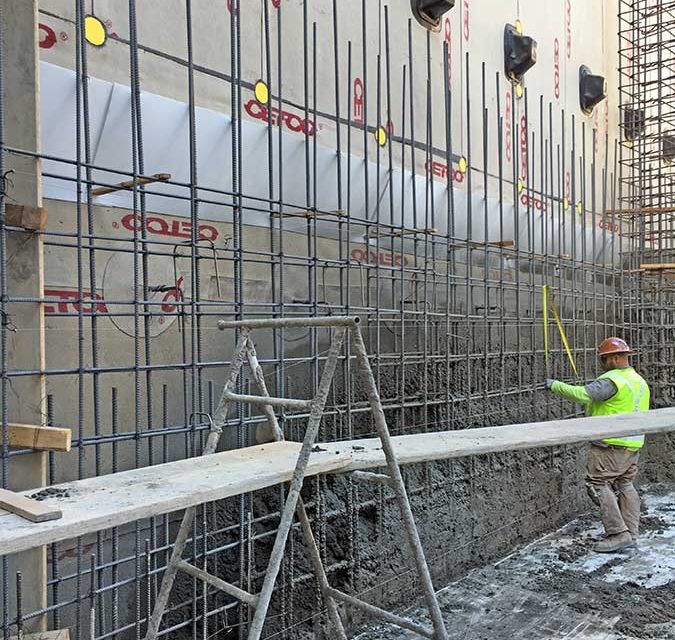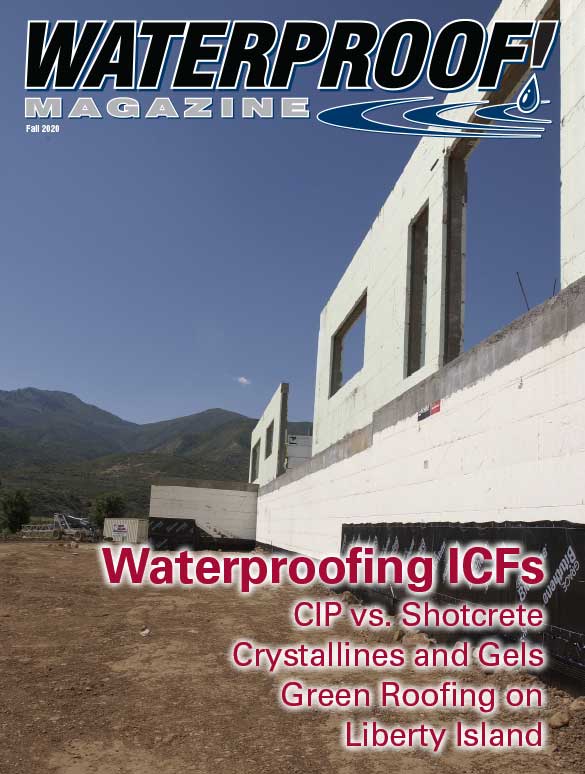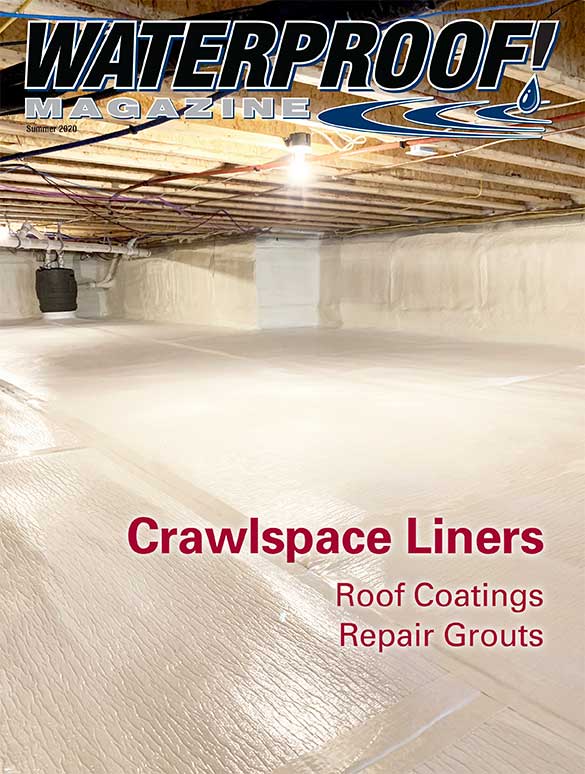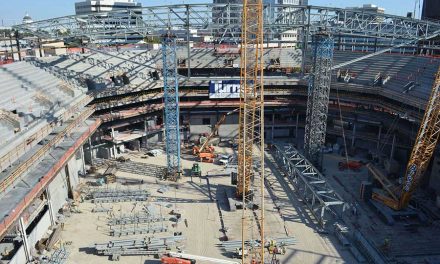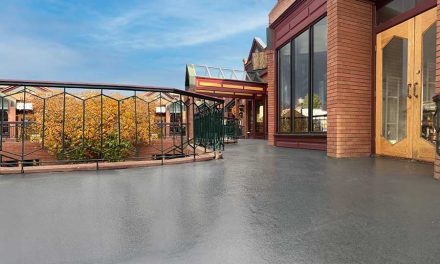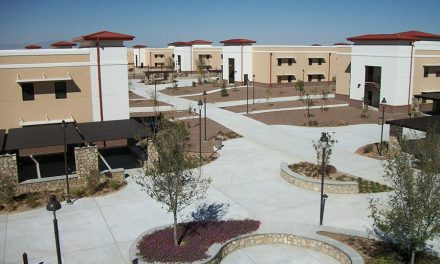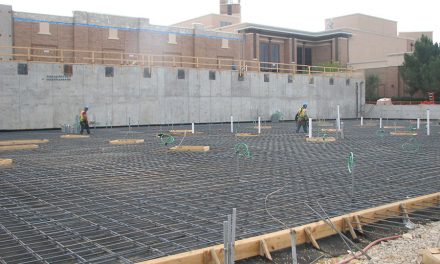By Stacy Byrd
Proper waterproofing is critical to the long-term success of a structure, yet making shotcrete watertight is often problematic. Be sure to team up with a waterproofing manufacturer who understands the nuances of waterproofing shotcrete.
With a history dating all the way back to early experiments conducted by Thomas Edison, cast-in-place concrete is a long-established method for creating concrete structures on site. In use for more than a century, today it is one of the most common systems for constructing slabs and foundations across the U.S.
In recent years, shotcrete has been rapidly gaining popularity in below-grade construction thanks to its lower construction costs. However, in below-grade foundation applications, use of shotcrete also results in higher incidence of water ingress, while the use of cast-in-place concrete provides several advantages, including exceptional waterproofing benefits.
What is Cast-In-Place Concrete?
Preferred for concrete slabs and foundations, cast-in-place (CIP, also known as poured-in-place) is an on-site concrete process where liquid concrete is poured into removable forms that are dismantled once the concrete has hardened, producing a solid structure in a desired shape on-site. It offers the advantages of a high level of strength and versatility for even the smallest or most ambitious projects.
What is Shotcrete?
Frequently used in underground applications, shotcrete is a wet- or dry-mix concrete that is pneumatically propelled at high velocity through a hose and nozzle. It does not require conventional forming and is an economical solution for the time and related costs it saves. And because the spray application process reduces the water/cement ratio, it’s generally stronger than CIP.
But shotcrete presents specific issues for preventing water ingress, especially in sub-surface applications.
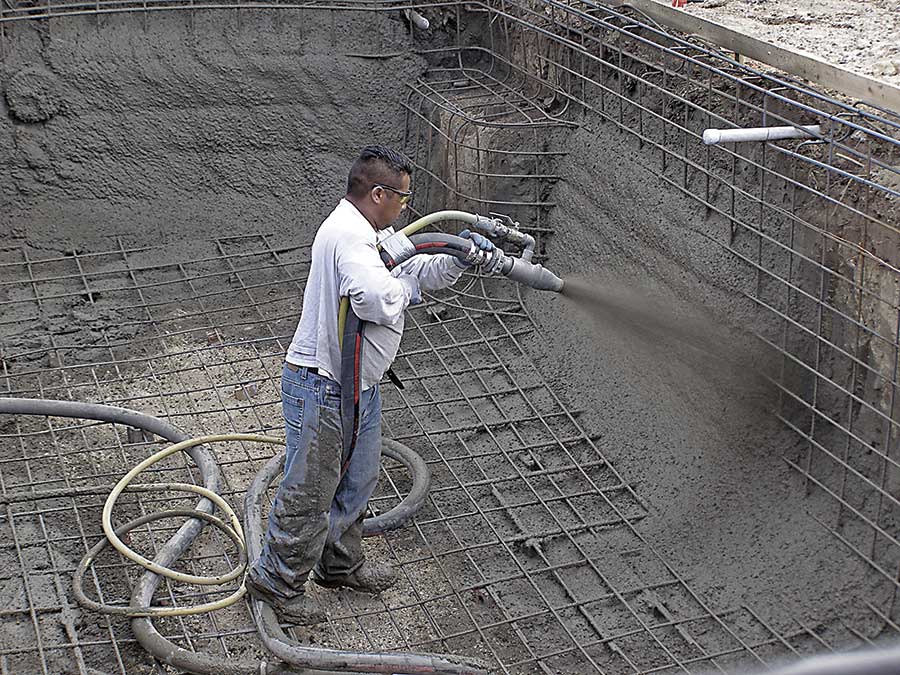
Shotcrete is a wet- or dry mix concrete that is pneumatically propelled at high velocity through a hose and nozzle that does not require conventional forming.
CIP Concrete Advantages
CIP concrete offers specific advantages over shotcrete, particularly when it comes to preventing water ingress:
- Superior structure to eliminate voids
- No requirement for full-scale mockup prior to installation
- Combines more effectively with waterproofing systems
Superior Structure to Eliminate Voids
Once poured in the molding forms, still in its plastic state, CIP concrete is vibrated in order to solidify it. This action removes any poorly consolidated pockets and ensures the material flows around and encapsulates any reinforcing steel or other structural/mechanical elements.
Without such a vibration step in shotcrete’s installation process, shadow voids and porous areas may result behind any structural/mechanical elements—such as rebar—that may have even partially blocked the spray of material during installation. This poor encapsulation of the reinforcement not only reduces the shotcrete’s quality, but also increases the likelihood of water ingress. Further, poorly mixed shotcrete can develop sand lenses, rebound pockets, and other defects, all of which can create pathways for water to flow within—and through—the finished shotcrete.
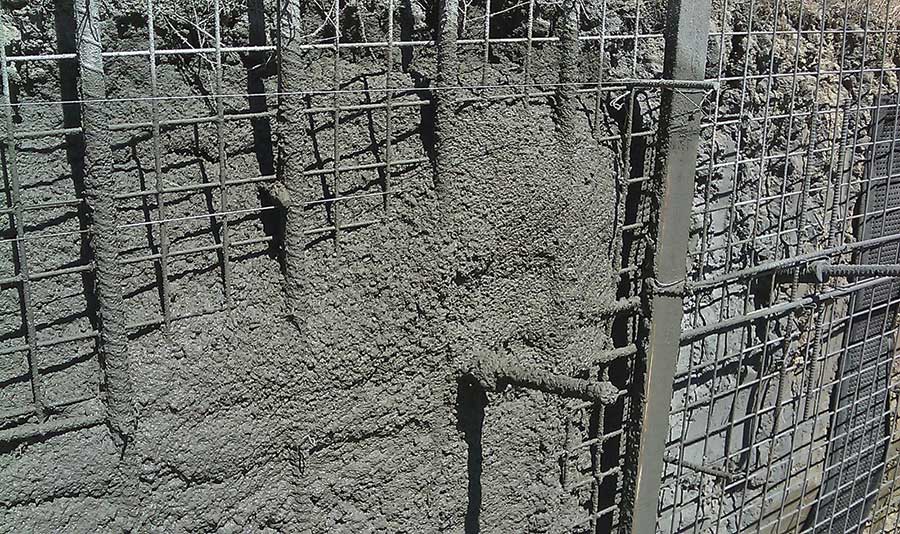
Shadow voids and porous areas may result behind structural/mechanical elements such as rebar, thereby reducing shotcrete’s quality and increasing the likelihood of water ingress.
Doesn’t Require Full-Scale Mockup
Prior to installation, shotcrete requires the added step and associated expenses of a full-scale mockup and repeated trial installations with the mockup. When performing a shotcrete installation, the ACI 506 Guide to Shotcrete strongly recommends pre-construction testing using a full-scale mockup of the installation location. From these trials, proper shooting procedures and application sequence are documented and detailed in the work plan, then tested in the mockup, which should include and simulate as closely as possible:
- The project-specific wall substrate
- The site’s waterproofing conditions
- The site’s reinforcement conditions
- All onsite logistical conditions
The mockup allows the nozzle operator to train and qualify under project-specific conditions. It may be necessary to set up and perform several mockup trials to optimize the system, modify the designated shooting procedures and application sequence, demonstrate the design works, and produce tested, proven procedures for a successful installation.
One primary key to a successful shotcrete project is a knowledgeable contractor with an experienced shotcrete crew—not just an expert nozzler. Though the nozzler has the greatest influence on the shotcrete placement, the quality of shotcrete application depends on the entire crew. The basic shotcrete crew may consist of a foreman, nozzler, assistant nozzler, finisher or rodman, wireman, pump and mixer operator, and laborers. In 2000, ACI, in cooperation with the American Shotcrete Association (ASA), established a formal training program for certifying shotcrete nozzlers. However, certification does not mean the nozzler is qualified for every project—for example, he or she may not have sufficient experience with heavily reinforced areas or complex structural geometry.
After the crew completes the practice installation, the mockup must be inspected and tested to determine the efficacy of the documented procedure and its success. In addition to the routine material quality tests (such as project-specified compressive strength) shotcrete cores must be retrieved and visual examined. Necessary for quality evaluation, this type of assessment can reveal for each mockup trial procedure imperfections—such as voids, sand lenses, and delaminations—as well as the degree the tested procedure encapsulates the reinforcing steel.
Preconstruction mockup—with repeated trials testing and all the associated time and costs—is critical to a shotcrete installation’s success. It must be specified and conducted as a required as part of the project plan.
For CIP, if a mockup is present it’s usually a single piece made available for the onsite crew as an installation reference for color, texture, etc.
More Effective with Waterproofing Systems
By nature, concrete is porous, allowing water to enter a below-grade structure by hydrostatic pressure, water vapor gradient, or capillary action. Water can also intrude on the structure via cracks or flawed joints. A structure must be protected from water not just for the damage it can cause to its contents, but to prevent structural damage to the concrete itself along with its steel reinforcement.
A waterproofing system, then, is critical to the concrete structure’s long-term reliability and success. Typically, a membrane providing an active or passive water barrier is attached to the concrete’s surface. A significant advantage with CIP concrete is that, when placed, the fluid material develops sufficient lateral confining pressure to position a waterproofing membrane against it.
Making shotcrete watertight, however, is problematic. Statistically, the majority of leaks over the past few years in the western United States have been on projects with structural shotcrete used on below-grade, blind-side foundation walls.
A problem arises for shotcrete installations because, historically, waterproofing material manufacturers have developed systems for use with conventional CIP concrete for both backfilled wall and blind-side applications. Many of them are being used today with shotcrete—waterproofing consultants have begun adding detailing and ancillary products to existing systems to adapt traditional CIP waterproofing assemblies for use with shotcrete. Unfortunately, it has also resulted in warranty conflicts—the ancillary product is not supplied by the manufacturer, and the detailing is not standard manufacturer guidance.
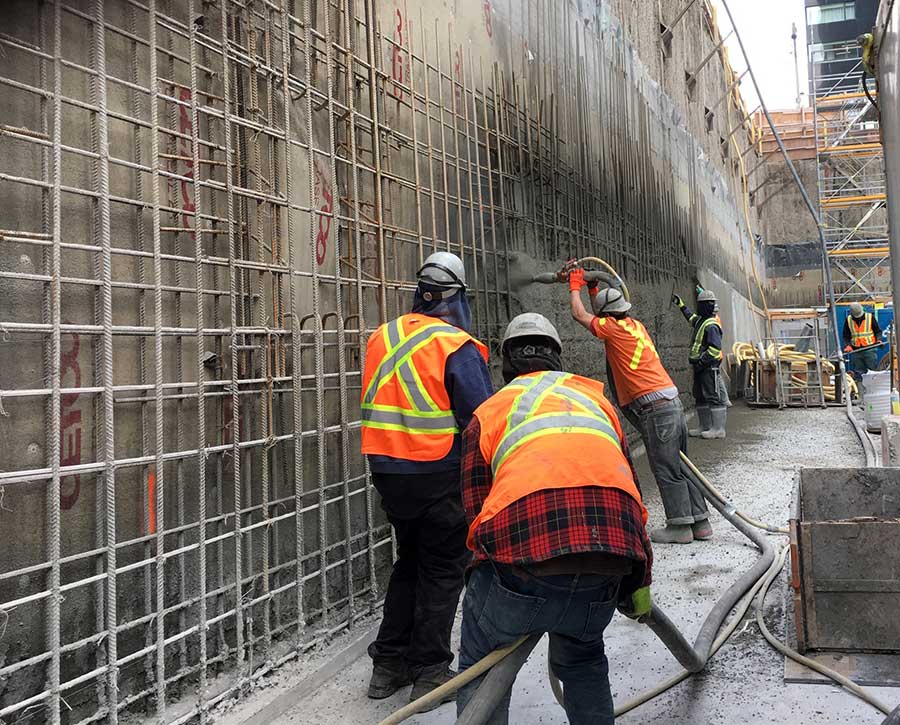
The key to a successful shotcrete project is an experienced shotcrete crew, which may consist of a foreman, nozzler, assistant nozzler, finisher or rodman, wireman, pump and mixer operator, and laborers.
Also, because of its lower application slump, shotcrete installation results in less lateral confining pressure on the waterproofing membrane. Waterproofing membrane sheets are mechanically hung from the shoring wall with minimal fasteners. So as the shotcrete is applied—sprayed into place—the membrane billows away from the solid backing of the shoring, with the shotcrete simply bouncing off the billowed membrane, which can result in voids between the membrane and shoring. These voids can compromise the stability of fully-adhered membranes, causing seam failure through a buildup of hydrostatic pressure on a membrane spanning a void.
And on a blind-side application, proper shotcrete consolidation on a smooth waterproofing membrane can be difficult, with membrane billowing and bridging increasing shotcrete rebound. The result can be poor consolidation and rebound pockets along the interface with the waterproofing. And the high-velocity force of the propelled shotcrete can compromise the seams of the waterproofing membranes by blowing open the overlaps—even taped ones.
Another CIP concrete advantage when waterproofing is that it doesn’t require the same level of reinforcement stabilization as shotcrete. Because there’s no need to pierce the waterproofing membrane with fasteners, a CIP concrete installation reduces the necessity of repeatedly puncturing the membrane, eliminating hundreds—if not thousands—of potential failure points in the waterproofing.
The spraying action of a shotcrete installation can also create waterproofing issues through overspray (waste shotcrete material deposited away from intended receiving surface). Shotcrete overspray collecting on a nearby waterproofing membrane can form a thin layer of cured concrete that bonds poorly with the shotcrete that’s later applied over it fully. When this happens, the membrane may only bond with the overspray and not the shotcrete structure itself.
With a CIP installation, of course, there is no high-velocity pneumatic spraying.
Conclusion
For waterproofing performance, conventional CIP concrete is more reliable than shotcrete, and has proven so through decades of successful installations.
Shotcrete is popular because it’s less expensive to install. However, its use has resulted in higher incidences of water ingress in below-grade foundations. Because of its inherent quality issues, it is considered a primary factor for failure in below-grade waterproofing systems. This will continue to be the case until manufacturers can fully address shotcrete’s waterproofing challenges by developing new systems or by adding ancillary products and detailing that have been designed specifically for shotcrete.

Stacy Byrd
Stacy Byrd, CDT, is the global technical services director at Cetco, a manufacturer of waterproofing, green roof systems, composite drainage, and waterstops. He has 30 years of waterproofing design application and practical field experience with below-grade foundations, plaza-decks, tunnels, and green roofs on commercial, institutional, civic, and government projects around the world. Byrd is an active member with ASTM International Committee D08 on Roofing and Waterproofing. He can be reached at stacy.byrd@mineralstech.com.
Fall 2020 Back Issue
$4.95
Cast-In-Place Concrete vs. Shotcrete: The CIP Advantage
Gel Waterproofing
Effective Waterproofing for ICFs
A Green Roof for Liberty Island
AVAILABLE AS DIGITAL DOWNLOAD ONLY
Description
Description
Cast-In-Place Concrete vs. Shotcrete: The CIP Advantage
By Stacy Byrd
Below-grade concrete can be cast-in place using forms or high-pressure shotcrete. A waterproofing expert evaluates the advantages of each method.
Gel Waterproofing
By Mario Baggio
Crystalline waterproofing and modified silicate gel-based approaches may look similar, but they work in different ways, and each has its own advantages.
Effective Waterproofing for ICFs
By Brian Corder
Insulated concrete forms (ICFs) become increasingly popular and are incompatible with solvent-based waterproofing. Manufacturers recommend water-based or self-adhered systems.
A Green Roof for Liberty Island
By Linda Velazquez
In New York Harbor, a new Statue of Liberty Museum in the shadow of the iconic statue boasts a state-of-the art sloping green roof.
Additional Info
Additional information
| Magazine Format | Digital Download Magazine, Print Mailed Magazine |
|---|

